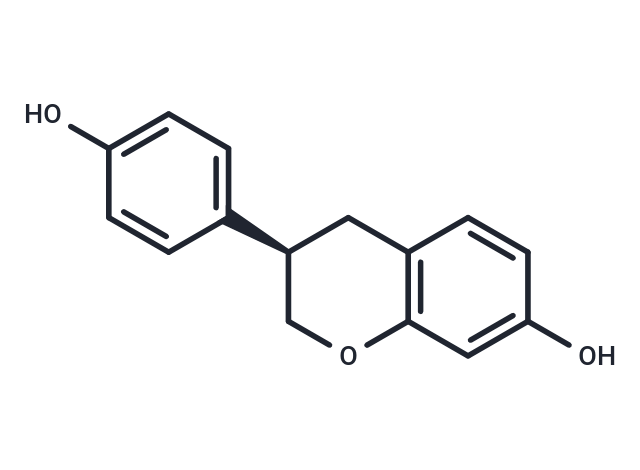Shopping Cart
- Remove All
 Your shopping cart is currently empty
Your shopping cart is currently empty

(R)-Equol ((+)-Equol) is an ERα and ERβ agonist with Kis of 27.4 and 15.4 nM, respectively.

| Pack Size | Price | Availability | Quantity |
|---|---|---|---|
| 5 mg | $34 | In Stock | |
| 10 mg | $58 | In Stock | |
| 25 mg | $97 | In Stock | |
| 50 mg | $143 | In Stock | |
| 100 mg | $215 | In Stock | |
| 200 mg | $317 | In Stock | |
| 1 mL x 10 mM (in DMSO) | $38 | In Stock |
| Description | (R)-Equol ((+)-Equol) is an ERα and ERβ agonist with Kis of 27.4 and 15.4 nM, respectively. |
| Targets&IC50 | ERβ:15.4 nM (Ki), ERα:27.4 nM (Ki) |
| In vitro | (R)-Equol produced a dose-dependent inhibitory effect on the invasive ability of MDA-MB-231 cells, and this inhibitory effect was obvious at the highest test concentration (50 μM).Following 48-h exposure to (R)-Equol, invasion is reduced by 62% (p=0.009, versus untreated cells) with 50 μM (R)-Equol. Matrix metalloproteinase-2 (MMP-2) expression is significantly down-regulated following treatment with 50 μM (R)-Equol (p=0.035) [2]. |
| In vivo | In animals, (R)-Equol significantly reduces the number of palpable tumors over time compared to controls (P=0.002). The number of palpable tumors per rat in the (R)-Equol-fed group is significantly lower than in rats treated with S-(-)equol (P=0.008). (R)-Equol-fed animals exhibit 43% fewer tumors than the control group, with this difference being highly statistically significant (P=0.004). The number of tumors per tumor-bearing animal is significantly lower in (R)-Equol-fed animals compared to controls (3.3±0.4 versus 5.5±0.5, P=0.004). At necropsy, the mean (±SEM) tumor weight per animal for (R)-Equol-fed rats (5.3±1.1 mg) is significantly reduced (P=0.04) compared to controls (9.9±1.4 mg). Feeding the (R)-Equol diet also results in significantly increased tumor latency (P=0.003) [3]. |
| Alias | (+)-Equol |
| Molecular Weight | 242.27 |
| Formula | C15H14O3 |
| Cas No. | 221054-79-1 |
| Smiles | OC1=CC=C(C=C1)[C@@H]1COC2=C(C1)C=CC(O)=C2 |
| Relative Density. | 1.31g/cm3 |
| Storage | Powder: -20°C for 3 years | In solvent: -80°C for 1 year | Shipping with blue ice. | |||||||||||||||||||||||||||||||||||
| Solubility Information | DMSO: 100 mg/mL (412.76 mM), Sonication and heating are recommended. | |||||||||||||||||||||||||||||||||||
Solution Preparation Table | ||||||||||||||||||||||||||||||||||||
DMSO
| ||||||||||||||||||||||||||||||||||||

Copyright © 2015-2025 TargetMol Chemicals Inc. All Rights Reserved.